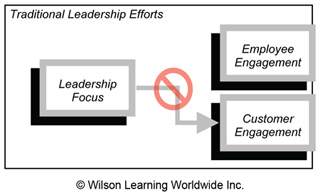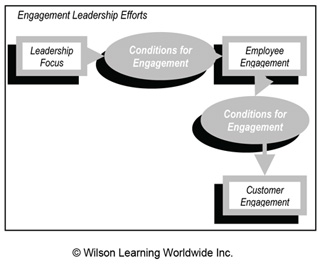Implication des salariés
Le rôle du leader (article Point de vue)

We've all heard about organisations with great strategies that somehow fail to execute in the marketplace. We also know of organisations that have long-term, highly satisfied customers who, for some mysterious reason, stop buying.
On the surface, it is easy to say that there are many uncontrollable factors contributing to these problems, such as politics or a global economic crisis. However, some organisations continue to enjoy greater levels of success in spite of these external forces. These organisations succeed because of something called Engagement—a factor that may be playing a more significant role in business than previously believed.
Engagement represents the conditions under which people (employees and customers alike) make an emotionally-based choice to be loyal to a company. For customers, this choice is typically demonstrated as reliable, repeat business and voluntary, positive brand support. Employees demonstrate engagement through a positive expenditure of their discretionary energy and a clear commitment to the organisation's vision, strategies and goals.
The results of these choices are evident, with studies supporting the notion that "high engagement" organisations enjoy higher productivity and profits than "low engagement" organisations. Engaged customers provide greater revenue, sustain market share and are less susceptible to being drawn away by competitors. Engaged employees provide greater productivity with higher levels of performance and are less likely to be drawn away by bigger salaries or better working conditions.
While the benefits of engagement are well defined, these same studies also suggest an increased movement away from engagement for employees. These studies clearly indicate that only a very small percentage of employees are fully engaged in most organisations and an increasing number of employees are disengaging—sometimes by seeking employment elsewhere or, potentially worse, remaining in a position without putting forth the necessary energy or commitment.
This is not news to many. Comments from leaders indicate that while they understand the importance of engagement, they find themselves fraught with more questions than ideas about actually creating employee engagement.
Traditional Approaches Focus Leaders in the Wrong Place
A first step toward addressing this issue is to clarify the relationship between employee and customer engagement. Many experts today encourage leaders to "create customer engagement," implying this is under a leader's direct control. The reality is that leaders can only create customer engagement through their employees. Successful leaders realise that to create customer engagement, they have to first create the conditions for employee engagement. Only then can leaders direct their employees' energies toward creating the conditions for customer engagement. The bottom line is, to keep engaged customers, an organisation must first have engaged employees!

Engaged customers appear when engaged employees become an unexpected addition to the customer experience. At the customer interface, this addition is obvious. For example, it's easy to see an emotional connection in action when you as a customer feel that everybody knows your name at the corner coffee shop. What is less obvious, but just as critical, is the engagement of those employees behind the scenes—those who are responsible for the quality of the products, operations and processes. Great relationships will not make up for bad coffee, uncompetitive prices or failures to maintain cleanliness in the coffee shop. Thus, all leaders, not just sales and service leaders, must focus on employee engagement.
But what exactly do leaders with engaged employees do differently? These leaders understand the importance of managing products, policies and operations. However, they also devote as much or more energy on creating the conditions for engagement. While it is ultimately an employee's decision whether or not to be engaged, these leaders create the working and cultural conditions in which employees are recognised and valued and feel challenged by their work.
When times are difficult, many leaders tend to focus on the numbers and become controlling, which ultimately results in less engagement. Successful leaders recognise that they need to create the conditions under which employees choose to be engaged and that doing so results in customer engagement.
Leading with both Form and Essence
So, how do leaders create the conditions for engagement?
Leaders need to demonstrate a clear genuineness in their actions toward employees. Just as a shouted, well trained, habitual, "Welcome to _______!" does little to evoke a genuine emotional connection as customers enter a retail establishment, less-than-authentic behaviour from leaders fails to motivate employees to engage. Unfortunately, employees have seen far too many examples of less-than-genuine communication from leaders. Fortunately, there is something leaders can do about that perception. They can pay attention to two factors at play in the art of creating emotional connections—Essence and Form: the being and the doing of leadership.

Essence is the quality of being a leader. It involves the values, emotional characteristics and clarity of purpose required to foster engagement. Think about the person in your life who had the most impact on you as a leader—a person to whom you felt compelled to give your energy and commitment. Most likely, it was someone who had a strong sense of Essence as a leader.
Form is what a leader says or does. It represents those decisions, actions and behaviours that demonstrate the leader's Essence. Key here is consistency; Form always reveals Essence. Self-serving or organisationally-biased leadership behaviours will rarely produce employee engagement. Instead, leaders need to understand their role in creating a culture of engagement and act with consistency between what they want to be as leaders and what they actually do.
Four Levels of Leadership
Understanding the two sides of leadership is important, but the bigger issue is how to put them into action. Leaders need to apply their leadership Essence and Form on four levels:
Leading Oneself: Being clear on what one wants to be as a leader is the first step in leading oneself. You need to lead yourself before you can lead others.
Leading Others (one-to-one): One-to-one leadership skills are often considered foundational, like communication skills, goal setting, delegating etc.
Leading Teams (one-to-group): In addition to one-to-one skills, leaders need to be able to lead and inspire individuals to work effectively together and achieve as a team.
Leading a Work Culture: We have found that the act of Leading a Work Culture is distinct from Leading Others or Leading Teams. Many leaders focus on improving their one-to-one and one-to-group skills. However, today's leader needs to understand what it takes to create a culture that enables the full engagement of employees.
A real opportunity exists for organisations to increase the level of employee engagement.
Leaders Who Focus on Creating a Culture of Engagement have More Engaged Employees
Companies with engaged employees see culture as a cause rather than an effect, and leaders are expected to take responsibility for creating a culture that makes it easy for employees to engage. But how exactly do leaders create such a culture? They start by focusing on the following key elements:
- Opportunity enables employees to emotionally connect with something important.
- Personal Accountability provides clear expectations and motivates employees to give their best.
- Validation tells employees that they matter and have a valued place in the organisation.
- Inclusion provides employees with information and offers them a chance to express thoughts and feelings.
- Community creates a sense of safety and support, where employees experience mutual interest and shared responsibility.

Résultats Clients:
While the above elements provide some very practical approaches to creating an engagement culture, the question remains: How does all of this translate into action for your leaders? At Wilson Learning, we believe the most successful leaders are those who combine Form and Essence with a strong focus on the engagement culture; these are the leaders who consistently:
- Demonstrate a clear commitment to their own leadership values
- Establish and lead with a common vision that guides strategy implementation
- Provide clear direction and goals that are reinforced by effective feedback, recognition and support
- Refocus people's energy to move positively through change
- Create win-win business agreements that lead to mutually satisfying outcomes
- Use a versatile interpersonal approach to build productive relationships and handle conflict
Pour en savoir plus, contactez Wilson Learning au 01 47 51 70 70 or rendez-vous sur notre site Internet at WilsonLearning.com.









 Merci de remplir ce formulaire afin de télécharger Implication des salariés | Le rôle du leader (article Point de vue)».
Merci de remplir ce formulaire afin de télécharger Implication des salariés | Le rôle du leader (article Point de vue)».



